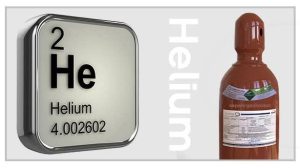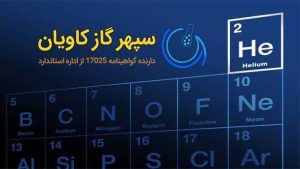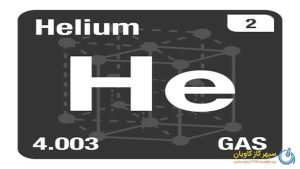Helium gas
Helium is a colorless, odorless, tasteless, non-toxic, inert, monatomic gas and the first in the noble gas group in the periodic table. Its boiling point is the lowest among all the elements, and it does not have a melting point at standard pressure. It is the second-lightest and second most abundant element in the observable universe, after hydrogen. It is present at about 24% of the total elemental mass, which is more than 12 times the mass of all the heavier elements combined.
Sepher gas kavian is a producer and importer of high quality laboratory gases and gas mixtures (calibration gases) and all related equipment for various industries. Sepher gas kavian supplies pure laboratory gases and mixed gases in percent, ppm, ppb such as this gas. (He) is active for lasers and semiconductors and has valid certificates.
Helium gas grade (5 99.999), helium grade 5.5 gas (99.9995), helium grade 6 gas (99.9999) are available.
Helium grade 99.999 gas is available in 5 liter carbon steel cylinder with 70 bar pressure, in 10 liter cylinder with 70 and 100 bar pressure, in 20 liter cylinder with 70 and 100 bar pressure and in 50 liter cylinder with 200 bar pressure.
Helium gas grade 99.9995 is available in a 50 liter carbon steel cylinder with a pressure of 200 bar.
Helium gas grade 99.9999 is available in a 50 liter carbon steel cylinder with a pressure of 200 bar.
Helium gas cylinder valve DIN6, BS3.

Sources
(He) is a non-renewable resource, meaning that it cannot be created artificially. The only way to obtain helium is to extract it from natural sources. The main sources of this gas are:
Natural gas: This gas is a byproduct of the natural gas production process. It is typically found in concentrations of 0.3% to 2.7% in natural gas deposits.
Uranium mining: This gas is also a byproduct of uranium mining. It is produced when uranium decays and releases alpha particles. These particles contain two protons and two neutrons, which can combine with two electrons to form(He) atoms.
Space: This gas is also found in the atmosphere of the sun and other stars. However, it is very difficult and expensive to extract this gas from space.
Here are some of the challenges associated with the resources of this gas:
Limited supply: (He) is a non-renewable resource, meaning that it cannot be created artificially. The only way to obtain this gas is to extract it from natural sources. However, the natural sources of this gas are limited, and the supply is expected to become increasingly scarce in the future.
Produce
This gas is generally produced in two ways:
- Simultaneous production with natural gas extraction: it is produced simultaneously with the extraction of natural gas from natural gas reservoirs. In some gas reservoirs of the earth, this gas exists naturally along with natural gas. In the natural gas extraction process, it is separated from natural gas and produced as a byproduct.
- Production from nuclear processes: This gas is unintentionally produced in nuclear processes. In nuclear reactors, nuclear processes such as nucleation and fission can be produced. This production occurs due to nuclear and nuclear changes during the nuclear process.
This gas is one of the rare and limited gases, its supply and production must be done carefully and in accordance with resource management. Sustainable use of this gas resources and conducting research for the development of new production methods are also of particular importance sepehr gas kavian .

Technical Specifications
| Chemical symbol | He |
| Atomic number | 2 |
| Atomic mass | About 4.0026 g/mol |
| Boiling point | About -268.93 degrees Celsius |
| Melting point | About -272.2 degrees Celsius |
| Physical state (in standard conditions) | Gas |
| Color | Colorless |
| Smell | Odorless |
Application
This gas is used in a variety of industries, including:
Aerospace: (He) is used in balloons, blimps, and airships. It is also used to pressurize fuel tanks in rockets and spacecraft.
Cryogenics: This gas is used to cool superconducting magnets and other cryogenic devices. It is also used to create ultra-low temperatures in research laboratories.
Medical: This gas is used in MRI scans and cryotherapy. It is also used to treat respiratory ailments such as asthma and emphysema.
Manufacturing: (He) is used in welding, leak detection, and high-altitude research. It is also used to make fiber optics and semiconductors.
Other: Helium is also used in a variety of other applications, such as inflating weather balloons, making party balloons, and filling voice balloons in cartoons.

Danger
Helium is a non-toxic, inert gas, and it is generally safe to handle and use. However, there are some potential dangers associated with this gas, including:
Asphyxiation: (He) is lighter than air, so it can displace oxygen in the lungs. If you breathe in pure helium, you will quickly become oxygen-deprived and pass out.
Gas embolism: If you inhale this gas from a pressurized tank, the gas can enter your bloodstream and cause a gas embolism. This is a serious condition that can lead to death.
Frostbite: Liquid helium is extremely cold, and it can cause frostbite if it comes into contact with your skin.





